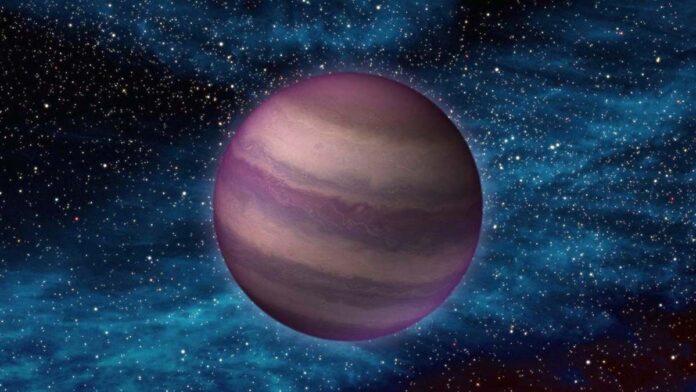Scientists have discovered a record-breaking binary star system consisting of two ultracool dwarf stars so close to each other that they complete an orbit in under a day.
The stars are separated by just around 1.5 million miles, about 1% the distance between the Earth and the sun, which means a year for these stars lasts just 17 hours. This makes the star system the tightest ultracool dwarf binary ever found.
The binary system, designated LP 413–53AB and located in the constellation of Taurus, was discovered by Northwestern University and the University of California San Diego (UC San Diego) astrophysicists using the W. M. Keck Observatory on the slopes of the dormant Maunakea volcano in Hawaiʻi.
“It’s exciting to discover such an extreme system,” Chih-Chun “Dino” Hsu, the leader of the team and a Northwestern University astrophysicist said in a statement. (opens in new tab) “In principle, we knew these systems should exist, but no such systems had been identified yet.”
Related: Astronomers witness the rare break up of a star couple
Ultracool dwarfs are one of the most common star types in the universe, but these low-mass stars are so cool that most of the light they emit is in the form of an infrared glow. This means they are invisible to the human eye and tough to detect. Short-period binaries of these stars are even rarer.
Prior to the discovery of LP 413–53AB astronomers had only detected three ultracool dwarf binaries with short-period orbits, all of which were less than 40 million years old, practically infants compared to our 4.6 billion-year-old sun.
The team estimates that LP 413–53AB, on the other hand, is much older than the stars in the previously known systems, possessing an age of several billion years, much closer to that of the sun. The system’s orbital period is about four times shorter than the orbital period of the tightest of the previously discovered ultracool dwarf binaries..
The team first discovered this record-breaking binary while searching through archival data, with Hsu noticing something strange about the spectrum of light coming from LP 413–53AB. Early observations had caught the binary as the stars were aligned, meaning their spectral data overlapped and they were mistaken for a single star.
The spectral lines then split, moving in opposite directions as the stars continued in their orbits, tipping Hsu off to the fact that he was actually looking at two stars. The astrophysicist also realized these stars must be locked in a very tight binary system.
Following up on this revelation with the Keck Observatory’s Near-Infrared Spectrograph (NIRSPEC), Hsu and the team performed several observations of the system between March 2022 and January 2023. These observations confirmed Hsu’s prediction that the distance between the stars is about 1.48 million miles.
“When we were making this measurement, we could see things changing over a couple of minutes of observation,” Hsu’s Ph.D. advisor and UC San Diego astrophysicist Adam Burgasser, who is a co-author of the study, said in the statement. “Most binaries we follow have orbit periods of years. So, you get a measurement every few months. Then, after a while, you can piece together the puzzle. With this system, we could see the spectral lines moving apart in real-time. It’s amazing to see something happen in the universe on a human time scale.”
The team theorizes that the stars may have migrated towards each other over their lives as they evolved. Alternatively, they may have been part of a three-body star system, moving together when the third companion was ejected. Confirming these theories will require further observations of the LP 413–53AB system.
Hsu believes that studying other ultracool dwarf binaries could help us learn more about potentially habitable worlds outside of the solar system, extrasolar planets, or “exoplanets.” Because ultracool dwarfs are far less hot than the sun, the region around these stars at which liquid water could exist, known as the “habitable zone,” would be much closer to the star.
Life existing in a habitable zone around LP 413–53AB is almost out of the question, however. This is because the habitable zone distance for these stars would be close to the size of their orbit meaning planets are unlikely to form because the motion of the stars and their radiation would disperse the material needed to collapse and form planets.
“These ultracool dwarfs are neighbors of our sun,” Hsu said. “To identify potentially habitable hosts, it’s helpful to start with our nearby neighbors. But if close binaries are common among ultracool dwarfs, there may be few habitable worlds to be found.”
Hsu and Burgasser will investigate this possibility by continuing the hunt for further short-period ultracool dwarf binaries thus building a larger data sample than the very sparse one that currently exists.
“These systems are rare, but we don’t know whether they are rare because they rarely exist or because we just don’t find them,” UC San Diego Center for Astrophysics and Space Sciences researcher Chris Theissen, said. “That’s an open-ended question. Now we have one data point that we can start building on. This data had been sitting in the archive for a long time. Dino’s tool will enable us to look for more binaries like this.”
The team’s research is available as a preprint on the website ArVix (opens in new tab) and has been accepted for publication in The Astrophysical Journal Letters.
Follow us on Twitter @Spacedotcom (opens in new tab) or on Facebook (opens in new tab).

